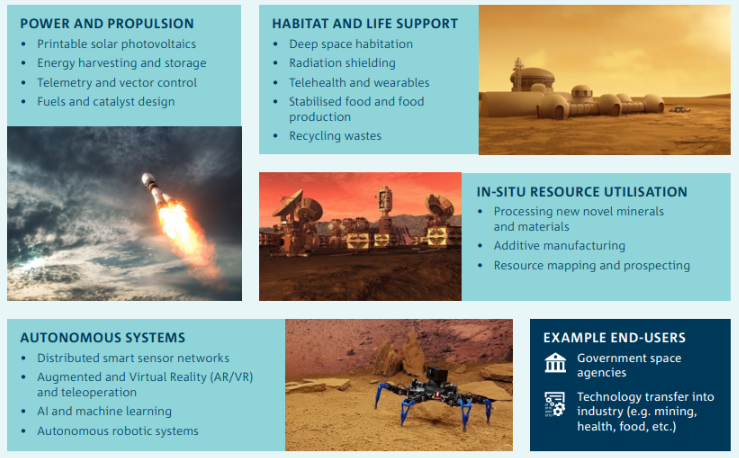Australia’s Commonwealth Scientific and Industrial Research Organisation (CSIRO) has set out a strategy for, “unlocking future growth opportunities for Australia.” The newly published report joins the earlier CSIRO’s Advanced Manufacturing Roadmap in highlighting the importance of additive manufacturing for the development of the space sector.
Australia hopes to benefit from the growing Space industry, enabled in part by 3D printing. Also known as Space 2.0, a decrease in the cost of accessing space technology has seen an influx of venture capital and private investment into a sector previously accessible only by national government and military level budgets.
Examples of private space enterprises include Space X and Rocket Lab. While such private enterprises have received funding and support from government/military launch contracts and grants, they are also backed by private investors. Furthermore, SpaceX, Rocket Lab and other companies such as Relativity Space, are all using additive manufacturing as an enabling technology for space ventures.

Australian space industry forecast to triple
The global space industry is valued at $345 billion, and Australia currently has a $2-3 billion share of this figure. In 2017, approximately 10,000 people were employed in the Australian space industry across 388 start-ups and the private sector – CSIRO Futures anticipate the industry will triple in size by 2030.
The latest roadmap was launched this week at the Australian Space Research Conference on the Gold Coast. CSIRO executive director Dr David Williams said, “We’re the home of titanium printing, 3D printing, we’ve got good remote mining capabilities in hostile conditions.”
The CSIRO report highlights a number of near and long term opportunities where 3D printing will have application. Working with a 10 year plus horizon, 3D printing could be used for in-space manufacturing and include such materials as metals and glass. Harnessing in-situ resources would reduce expenses related to space freight and make logistics a less complex operation.
“In-situ resource extraction and utilisation is enabled by semi-autonomous 3D printers operated alongside human-in-the-loop excavation systems that transform raw lunar regolith into building structures,” states the report.
Also in the long-term, 3D printing may have application in habitat and life support – especially as space missions increase in duration as settlement projects get underway. The lunar habitats of the 2030’s – as envisioned by CSIRO – feature autonomous robots roaming the surface and using 3D laser scanning to seek out and map lava tubes as opportunities for potential dwellings.
Synthetic biology research is anticipated to contribute to the production of resources on the moon whereby, “Using gas fermentation, carbon is processed to produce macronutrients for food, as well as for use in metallic 3D printing, where in-situ titanium oxide and anorthite are reduced to titanium and aluminium.”

Surviving harsh conditions
The emerging Space industry includes some enterprises that are prone to bold proclamations, with projects that still require many challenges to be overcome. For example, both Elon Musk’s SpaceX and NASA’s mission to Mars will need to tackle, among other issues, the threat posed by radiation to astronauts. Here again 3D printing may be part of the solution. Experiments on the ISS have used the Made in Space 3D print to fabricate radiation shields. NASA’s 3D printed chain mail is another avenue of investigation for ensuring the safety of astronauts.
Dr. Williams acknowledged the challenges, but was keen to highlight the difficulties could be overcome, “”I think it should be achievable. If you look at the US position, the President has declared that a lunar base is a prerequisite for going to Mars, and he has changed the focus of NASA to try and do a lunar base.”
Australia Space Agency (ASA) head Dr Megan Clark also spoke during the Gold Coast event and highlighted both Australia’s historic role in space exploration, specifically the Apollo missions to the moon, and also the terrestrial conditions in parts of Australia that also provide useful experience. “All of the aspects of living and operating in those really harsh environments … actually Australia has a lot to contribute,” said Dr. Clark.
For all the latest additive manufacturing news, subscribe to the 3D Printing Industry newsletter, and join us on Facebook and Twitter.
Start a new career or find additive manufacturing experts, visit our 3D printing job site now.



